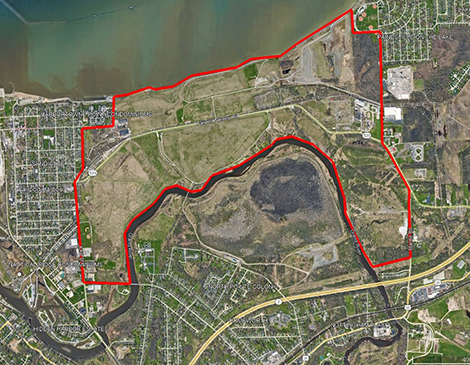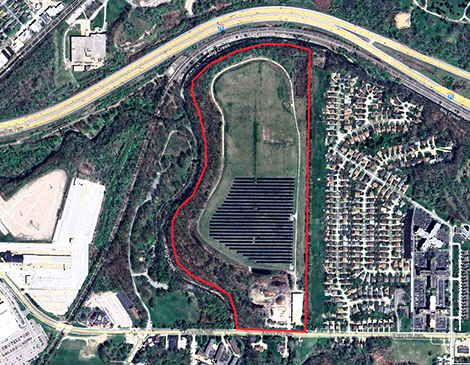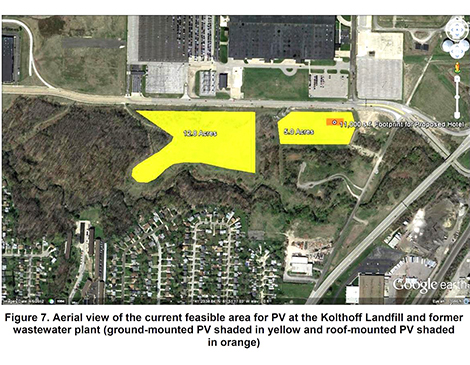This article was published as part of an exclusive content partnership with neo-trans.blog.
The U.S. Environmental Protection Agency (USEPA) today awarded $129.4 million in federal funding to the Greater Cleveland area to produce cheaper, more competitive, cleaner electricity locally. The funded work includes constructing five solar arrays in four communities, closing a coal-fired power plant in Painesville and supporting reforestation efforts in a community once called the Forest City.
Funding will support a Cuyahoga County-led effort, including the cities of Cleveland and Painesville, in their transition from reliance on the fossil-fueled generation of electrical power. The grant will fund the deployment of 63 megawatts (MW) of solar installations on brownfield and previous landfill sites and 10 MW of battery storage.
This follows Cuyahoga County’s creation in 2021 of the nation’s first microgrid utility, Cuyahoga Green Energy. In December 2023, it contracted with Compass Energy Platform to serve as the operator for the county-run utility.
While traditional microgrids typically serve single customers or a small number of adjacent customers, Cuyahoga Green Energy’s community microgrids will serve multiple interconnected customers. These customers will share resources, including solar panels and batteries, so that energy can be used more strategically.
The USEPA grant will also support the restoration of natural habitats and expand tree coverage on the blighted 1,100-acre former Diamond Shamrock chemical plant on Fairport Nursery Road in Painesville, located in Lake County. West Creek Conservancy is involved in the restoration project of that brownfield site along Lake Erie and the Grand River. The chemical plant operated from 1912-1977.

The funding will create meadows with natural pollinator habitats at solar sites in Cuyahoga County and at the city-owned coal-fired power plant at Richmond and Prospect streets near downtown Painesville. The USEPA grant is intended to help the city and its workers transition from the closure of that power plant.
USEPA funded this effort among 25 projects nationwide because Cuyahoga County’s application said it will deliver the following benefits to reduce greenhouse gases and support communities:
- Invest in the development of utility-scale solar for Cuyahoga Green Energy, Cleveland Public Power and Painesville Muni Electric to support the transition to clean energy production and reduction of community dependency on coal power.
- Create over 200 new jobs and offer job retraining and transition for individuals who are employed at the Painesville coal-fired power plant.
- Revitalize contaminated brownfield sites through reforestation and conservation efforts. Plant 4,000 trees, reforesting 80 acres, and creating over 400 acres of native meadow and pollinator habitats that provide communities with accessible recreation.
- Improve the water quality of Lake Erie, which supplies drinking water to 11 million people, including all residents of Lake and Cuyahoga Counties.
“This grant is regional cooperation at work,” said Cuyahoga County Executive Chris Ronayne. “Spanning two counties, our federal partnership enables Cuyahoga Green Energy to offer solar energy to four cities with power that can source up to 11,000 homes. Our application of solar arrays on landfills and institutional properties provides clean energy to our communities. It’s a win-win for our climate and our communities.”
In Brooklyn, a 40-acre landfill north of Memphis Avenue and east of Big Creek closed in 2015. A 12-MW solar array was proposed, called the Cuyahoga Urban Renewable Project, to provide an energy source over property that would otherwise remain undeveloped.

The first phase creating 4-MW of solar output was built on 20 acres in 2018. USEPA funding will allow 8-MW of additional solar output on the remaining 20 acres.
In Brook Park, the city of Cleveland’s former Kolthoff Landfill which measures about 48 acres and is along and south of IX Center Drive, was identified by the U.S. Department of Energy’s National Renewable Energy Laboratory (NREL) in 2013 for a potential solar installation.
The site includes the 30-acre Brook Park landfill to the west and a former 18-acre wastewater treatment plant to the east. But only about 17.8 acres of the overall site was considered suitable for a solar installation.
In Cleveland’s Slavic Village, Cuyahoga Heights and Garfield Heights, the inactive Harvard Landfill, 7720 Harvard Rd. and occupying 100 acres along more than a mile of both sides of the Mill Creek valley, will gain solar arrays. On the other side of the Cuyahoga Valley, former landfill sites in Cleveland’s Old Brooklyn neighborhood are possible for solar projects.

Funding was among $4 billion awarded to 25 projects nationwide through the USEPA’s Climate Pollution Reduction Grants (CPRG) implementation grants that were authorized by Congress under the Inflation Reduction Act of 2022.
The Northeast Ohio Areawide Coordinating Agency submitted the application through a federal initiative called Municipal Empowerment for Clean Energy and Conservation (MECEC). The lead sponsor of the initiative is Cuyahoga County with support from two coalition members — the cities of Cleveland and Painesville.
For more updates about Cleveland, sign up for our Cleveland Magazine Daily newsletter, delivered to your inbox six times a week.
Cleveland Magazine is also available in print, publishing 12 times a year with immersive features, helpful guides and beautiful photography and design.




